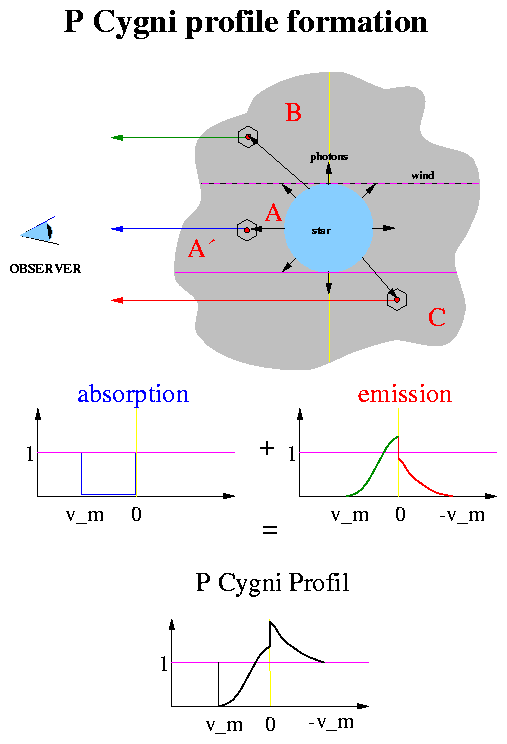Radius 52.9 million km (76 R☉) Mass 5.967 × 10^31 kg (30 M☉) | Surface temperature 18,700 K Magnitude 4.795 Apparent magnitude (V) 4.795 | |
 | ||
Similar 61 Cygni, Enceladus, Titan, La Superba, Hamal | ||
P Cygni (34 Cyg) is a variable star in the constellation Cygnus. The designation "P" was originally assigned by Johann Bayer in Uranometria as a nova. Located about 5000 to 6000 light-years (1500–1800 parsecs) from Earth, it is a hypergiant luminous blue variable (LBV) star of spectral type B1Ia+ that is one of the most luminous stars in the Milky Way.
Contents
Visibility
The star is located about 5000 to 6000 light-years (1500–1800 parsecs) from Earth. Despite this vast distance, it is visible to the naked eye in suitable dark sky locations. It was unknown until the end of the 16th century, when it suddenly brightened to 3rd magnitude. It was first observed on 18 August (Gregorian) 1600 by Willem Janszoon Blaeu, a Dutch astronomer, mathematician and globe-maker. Bayer's atlas of 1603 assigned it the miscellaneous label P and the name has stuck ever since. After six years the star faded slowly, dropping below naked-eye visibility in 1626. It brightened again in 1655, but had faded by 1662. Another outburst took place in 1665; this was followed by numerous fluctuations. Since 1715 P Cygni has been a fifth magnitude star, with only minor fluctuations in brightness. Today it has a magnitude of 4.8, irregularly variable by a few hundredths of a magnitude on a scale of days. The visual brightness is increasing by about 0.15 magnitude per century, attributed to a slow decrease in temperature at constant luminosity.
P Cygni has been called a "permanent nova" because of spectral similarities and the obvious outflow of material, and was once treated with novae as an eruptive variable; however its behaviour is no longer thought to involve the same processes associated with true novae.
Luminous blue variable
P Cygni is widely considered to be the earliest known example of a luminous blue variable. However it is far from a typical example. It has been largely unvarying both in brightness and spectrum since a series of large outbursts in the 17th century, whereas typical LBV behaviour is to show slow variation on a period of years to decades with occasional outbursts where the star shows a significant decrease in temperature and increase in visual brightness at roughly constant luminosity. P Cygni on the other hand, shows only relatively minor brightness and spectral variations, but underwent at least two of the giant eruptions shown only by Eta Carinae and possibly a handful of extra-galactic objects.
P Cygni does show evidence for previous large eruptions around 900, 2,100, and possibly 20,000 years ago. In more recent centuries, it has been very slowly increasing in visual magnitude and decreasing in temperature, which has been interpreted as the expected evolutionary trend of a massive star towards a red supergiant stage.
Evolution
Luminous blue variables like P Cygni are very rare and short lived, and only form in regions of galaxies where intense star formation is happening. LBV stars are so massive and energetic (typically 50 times the mass of the Sun and tens of thousands of times more luminous) that they exhaust their nuclear fuel very quickly. After shining for only a few million years (compared to several billion years for the Sun) they erupt in a supernova. The recent supernova SN 2006gy was likely the end of an LBV star similar to P Cygni but located in a distant galaxy. P Cygni is thought to be in the hydrogen shell burning phase immediately after leaving the main sequence.
It has been identified as a possible type IIb supernova candidate in modelling of the fate of stars 20 to 25 times the mass of the Sun (with LBV status as the predicted final stage beforehand).
P Cygni profile
P Cygni gives its name to a type of spectroscopic feature called a P Cygni profile, where the presence of both absorption and emission in the profile of the same spectral line indicates the existence of a gaseous envelope expanding away from the star. The emission line arises from a dense stellar wind near to the star, while the blueshifted absorption lobe is created where the radiation passes through circumstellar material rapidly expanding in the direction of the observer. These profiles are useful in the study of stellar winds in many types of stars. They are often cited as an indicator of a luminous blue variable star, although they also occur in other types of star.
Companion
It has been proposed P Cygni's eruptions could be caused by mass transfer to a hypothetical companion star of spectral type B that would have a mass between 3 and 6 times the mass of the Sun and would orbit P Cygni each 7 years in a high eccentricity orbit. Infall of matter into the secondary star would produce the release of gravitational energy, part of which would cause an increase of the luminosity of the system.
